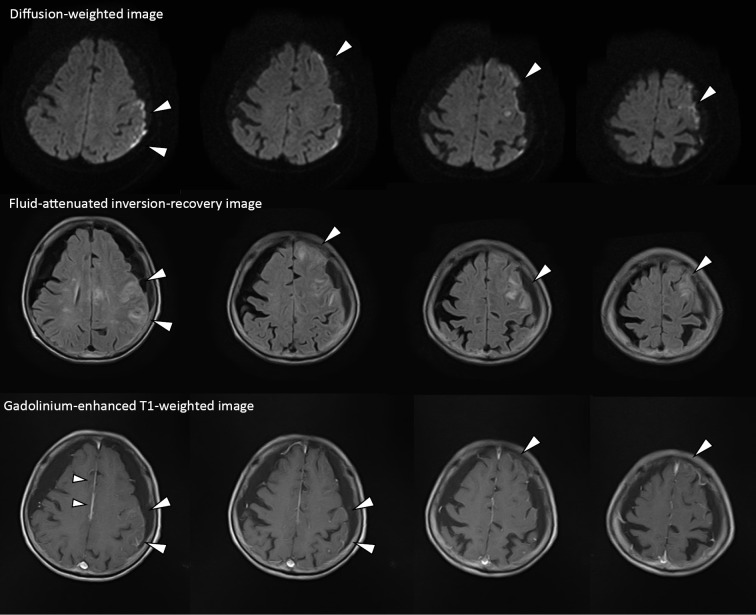An 84-year-old Japanese woman without any known impaired cognitive disorders was diagnosed with rheumatoid arthritis (RA). The patient thereafter developed an impaired consciousness, and her DAS28 score was highly elevated at 5.27. Her symptoms did not improve with golimumab, and the laboratory findings showed highly-elevated levels of anti-cyclic citrullinated peptide antibody up to 7,843.6 U/mL in serum (normal range, 0-4.4) and 25.4 U/mL in the cerebrospinal fluid. Brain MRI demonstrated high-intensity spots in the left cerebral pia mater, subarachnoid space, and parenchyma, which were enhanced with gadolinium contrast agent, as well as bilateral subdural edema (Picture). Under a diagnosis of rheumatoid meningoencephalitis, the patient underwent corticosteroid therapy, which improved both her consciousness and the MRI findings.
Picture.
Central-neurologic involvement of RA can occur as a result of meningeal and encephalic parenchymal inflammation due to necrotizing arteritis of the vasa vasorum (1). Possible differential diagnosis in this case includes tumor necrosis factor (TNF)-alfa inhibitors-induced demyelinating lesions, which, however, was not apparently depicted in MRI. Although no definitive treatment strategy has yet been established, high-dose corticosteroid therapy in combination with biological agents can possibly suppress the progress (2). Physicians should include rheumatoid meningoencephalitis in the differential diagnosis when a patient with RA newly develops any neurological symptoms.
The authors state that they have no Conflict of Interest (COI).
References
- 1.DeQuattro K, Imboden J. Neurologic manifestations of rheumatoid arthritis. Rheum Dis Clin North Am 43: 561-571, 2017. [DOI] [PubMed] [Google Scholar]
- 2.Atzeni F, Talotta R, Masala IF, Gerardi MC, Casale R, Sarzi-Puttini P. Central nervous system involvement in rheumatoid arthritis patients and the potential implications of using biological agents. Best Pract Res Clin Rheumatol 32: 500-510, 2018. [DOI] [PubMed] [Google Scholar]



